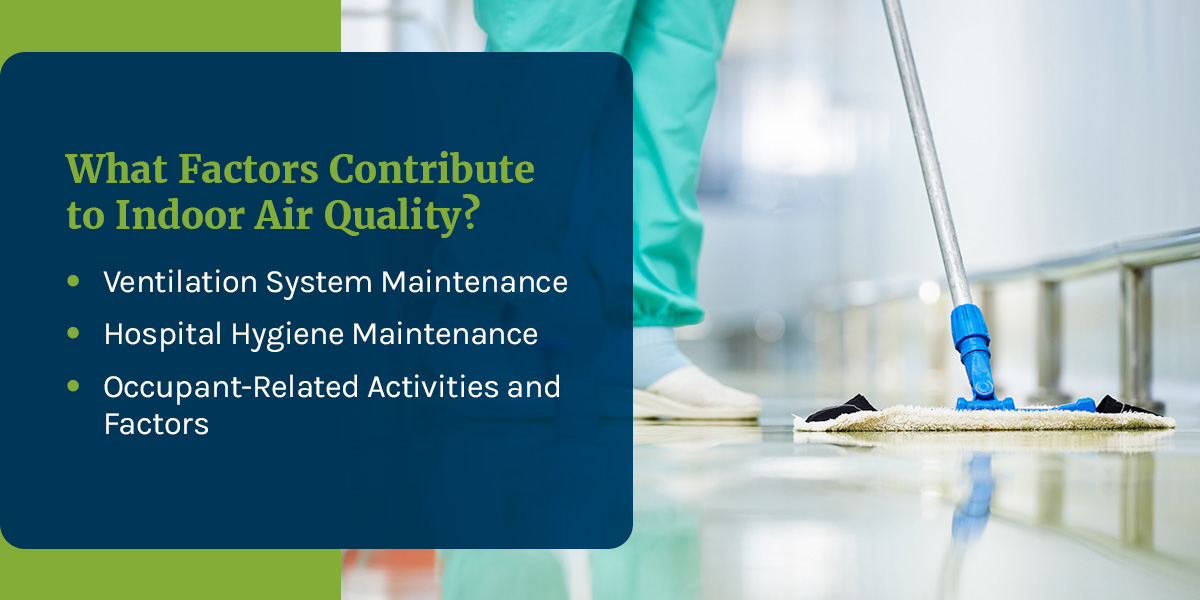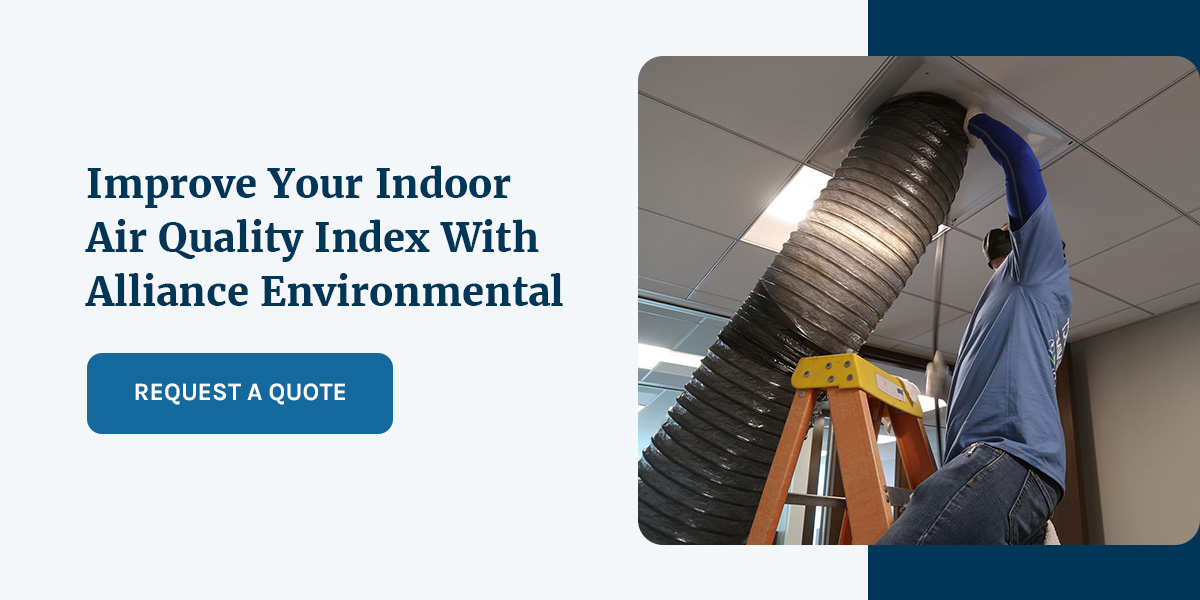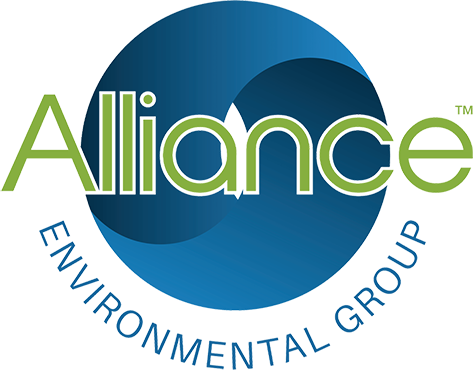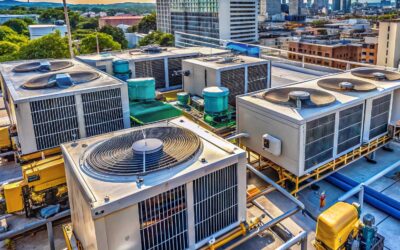
Indoor air quality is important, especially in healthcare facilities. Hospitals, clinics and offices must often meet and maintain several requirements and standards for air quality. However, several factors contribute to poor air quality and there are multiple ways these facilities can improve air quality in easy and sustainable ways.
Routine practices, occupant activities and ventilation systems significantly impact air quality. We’ve listed the six levels of air quality and the causes of indoor air quality in healthcare facilities so you can address your concerns and create a safe and comfortable environment for patients, guests and employees.
What Are the Six Levels of Air Quality?
Indoor air quality details how healthy the air is and whether there are significant pollutants in the area. The U.S. air quality scale quantifies air quality from zero to 500. The higher the air quality value, the more contaminants are present and pose more health risks. An acceptable air quality index will fall at or below 100.
These are the six levels of air quality:
- Good: Air quality falls in the “good” range when it reaches no higher than 50 on the air quality index. Good air poses little to no threat to anyone.
- Moderate: Moderate air quality is acceptable for most people. However, some highly sensitive groups may face minor health concerns. The range for this category is between 51 and 100.
- Unhealthy for sensitive groups: Sensitive groups refer to those who may face health risks due to a medical condition, innate susceptibility or exposure conditions. People in this group may have lung or heart disease or diabetes. Children and older adults typically fall into this group. This category ranges between 101 and 150 on the scale.
- Unhealthy for the general public: The general population can face health risks when air quality reaches between 151 and 200. Sensitive groups can experience severe effects from air exposure in this category. Everyone should reduce heavy or prolonged exertion when the air is in this category.
- Very unhealthy: This range spans from 201 to 300. If the air quality reaches these levels, everyone may face serious health risks. The general population may experience widespread effects.
- Hazardous: Hazardous levels are 301 or higher. Media outlets will trigger health warnings of emergency conditions if the air quality reaches these levels. The entire population may face serious health risks at these levels.

What Factors Contribute to Indoor Air Quality?
A normal indoor air quality level is essential for patients to reach a safe and timely recovery. Poor air quality can decrease productivity and cause harmful symptoms like irritation in the eyes, throat and nose. Additionally, poor air quality can worsen existing conditions and cause respiratory problems. Review these factors affecting air quality and discover how you can improve the environment for your patients and staff.
Ventilation System Maintenance
Ventilation systems play a significant part in polluting the air. Mechanical ventilation can lower airborne particle levels more effectively than natural ventilation. Additionally, centralized ventilation offers effective chemical and particle control, but you must have the proper maintenance routine in place.
Dust, debris, allergens and other contaminants can quickly gather in these units and duct work, allowing pollutants to spread throughout hospital rooms and hallways. Poor or inefficient ventilation maintenance can help spread infectious diseases, impacting everyone who enters the facility. Healthcare facilities must request professional cleaning and maintenance services to keep ventilation systems clean and working efficiently.
Hospital Hygiene Maintenance
Regular cleanings prevent the spread of germs that can make patients, guests and staff sick. Cleaning can remove many surface germs, and sterilizing can reduce any germs or particles left after cleaning. Disinfecting can kill harmful bacteria on surfaces, lowering the risk of disease spreading.
Irregular cleaning in healthcare facilities can lead to particle buildup, which can enter the air and travel throughout the facility. Some items, such as vacuum bags, can accumulate mold, making it crucial to clean and replace these items on a regular cadence. Some disinfectant and cleaning activities can also facilitate mold growth and release harmful organic compounds. Proper cleaning routines will lower some of these risks and create a safer environment for everyone.
Occupant-Related Activities and Factors
Several activities can impact indoor air quality. Medical and occupant activities can contribute to poor air quality, making it essential to develop the safest practices for performing these activities and reduce contaminants after the activity is complete.
Occupant activities produce carbon dioxide, bioaerosols and chemical pollutants. Overcrowding also contributes to poor air quality. Additionally, some medical activities and therapies can lead to a release of radon, nitrogen dioxide, phthalates, bioaerosols and anesthetic gases.
How to Meet and Improve Indoor Air Quality Standards
Efforts to reduce allergy systems, asthma flares and respiratory condition symptoms are essential for providing quality care. Several simple changes make it possible to reduce air contaminants, and healthcare facilities can easily implement these actions into routines to create a safe and comfortable environment. Here are several steps you can take:
- Maintain ventilation: Ventilation is one of the best ways to improve air quality. HVAC cleaning and maintenance are essential for an efficient ventilation system. Request regular cleaning services to remove pollutants and ensure your system works properly to improve air quality. Additionally, request maintenance services to replace air filters, lubricate moving components and repair broken elements.
- Practice clean routines: Cleaning is one of the best ways to reduce harmful particles and bacteria. Establish effective routines that ensure the safety of everyone in the building. Common touchpoints require more regular cleaning, so implement a practical system for cleaning these areas and objects. Additionally, opt for cleaning products without harmful chemicals.
- Remove greenery: Although greenery can be beneficial for patients and staff, many plants foster mold over time. Patients that face allergies may also suffer from plant particles. Consider moving greenery to outdoor spaces.
- Reduce dampness: Damp indoor spaces can lead to mold buildup that can quickly harm those in the facility, potentially leading to coughing, asthma attacks and other respiratory concerns. Quickly addressing areas that have moisture or standing water can prevent mold from accumulating. Dehumidifiers can pull excess moisture from the air to prevent it from pooling in one location.

Improve Your Indoor Air Quality Index With Alliance Environmental
Alliance Environmental is an environmental and indoor air quality expert. We provide effective solutions for businesses and homeowners to address concerns like mold, demolition, insulation removal or replacement, heat treatments, lead and asbestos, HVAC cleaning, maintenance, repairs or replacements and much more.
We understand the importance of indoor air quality, and we want to help you improve the levels at your facility. With over 100 years of combined experience, we’ve become a leader in our industry, ready to help everyone create a safer and healthier environment. Request a quote from us to discover how we can help your facility.



